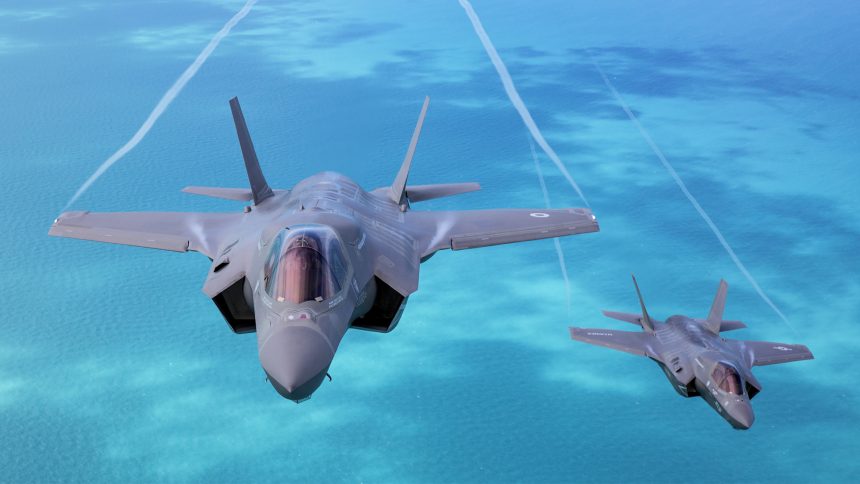The Collision Avoidance Manual Deconfliction is being tested on the F-35 at Edwards AFB and is intended to reduce the risk of midair collision with civilian and military aircraft.
The United States and the United Kingdom are jointly developing a new safety system for the F-35 Lightning II, aimed at avoiding midair collisions between military and civilian aircraft. The development was first reported by Aviation Week few days after an incident between a U.S. Air Force B-52 Stratofortress and a Delta Embraer E175 made the headlines, with the latter performing an “aggressive go-around” to avoid the bomber.
According to Kevin Price, an Air Force Research Laboratory (AFRL) program manager quoted by Aviation Week, the new “Collision Avoidance Manual Deconfliction” (CAMD) system is currently in testing on the F-35 test fleet at Edwards Air Force Base, California. The development of the CAMD technology is not the result of recent events, as it has been in the works for several years.
Collision Avoidance Manual Deconfliction
According to Price, the system was initially an unfunded AFRL proposal. Later on, the UK Ministry of Defense and the AFRL agreed to share the development costs, with each paying for half.
The involvement of the UK should not be surprising, as the country has been working to make safer the coexistence of civilian and military traffic in the same airspace. For an instance, the UK was one of the first countries to equip all its military aircraft with ADS-B (Automatic Dependent Surveillance – Broadcast) and is adopting technologies on the Protector RG1 unmanned aircraft to safely fly it in non-segregated airspace without compromising safety.
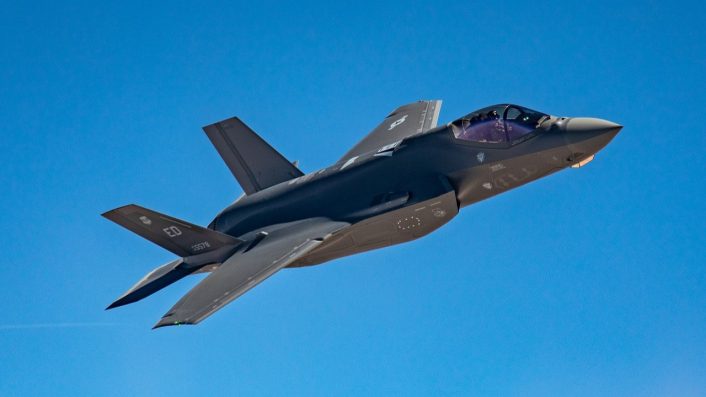
“The whole reason that the UK came to us for this collaborative program was they wanted to mitigate the risk of an F-35 running into an airliner or commercial traffic in the UK,” Price explained.
Civilian aircraft, especially airliners and commercial aviation, are equipped with Traffic Collision Avoidance System (TCAS), which monitors the airspace around the aircraft for transponder signals, detecting potential threats and providing pilots with alerts and instructions to avoid collisions. A similar system is not yet available for military aircraft, but CAMD aims to change that.
According to Price, who presented the system during a teleconference at the Experimental Aircraft Association’s AirVenture convention in Oshkosh, the technology derives from an automatic collision avoidance system that AFRL is developing to prevent midair collisions between military aircraft.
The military technology is based on a datalink with the requirement of “a positioning update rate of at least 20 times per second, but ideally as high as 40.” The datalink must be present on both the aircraft considered in a collision scenario for the technology to work.
“It can work well for fighter aircraft,” Price said. “We can be 500 ft. of each other and doing some extremely aggressive maneuvering, and the system will work and not engage in that situation unless the aircraft are going to hit.”
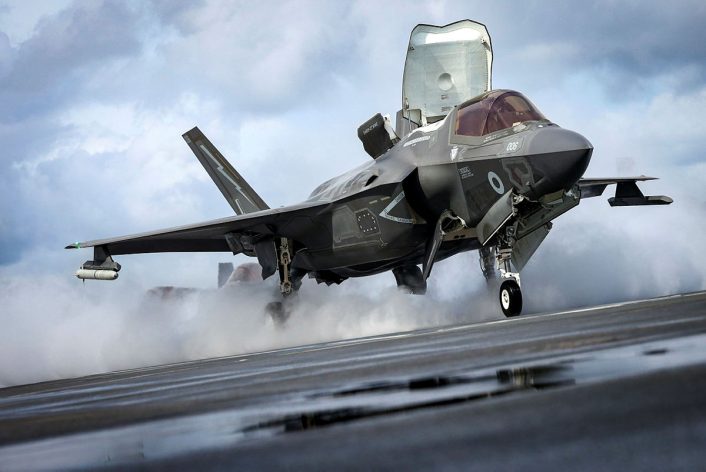
However, the automatic air collision avoidance system only works if both the aircraft involved in the potential midair are military aircraft. The problem is that there isn’t a common data link shared by both civilian and military aircraft, and the CAMD team is looking to overcome this obstacle.
Price is confident that the CAMD technology will work, although there are no details yet about the possible solutions to the problem. Also, Price mentioned that the F-35 Joint Program Office has not yet a timeline for the integration of CAMD on the F-35 as part of the Block 4 upgrade.
“They’ve deferred it from the Block 4 update,” said Price. “So now, that said, when they did that, the good news is they didn’t vote it off the island. They were throwing things out left and right, and we came really close to seeing the program like completely just removed from F-35 consideration.”
While the timeline is not yet clear, the team is developing and testing the technology to be ready when the time comes. However, getting there was not straightforward.
“Why that was problematic is that if they didn’t make it a requirement on the F-35 then they wouldn’t let us have access to flight test aircraft, or to the production team at Lockheed, or the test stands at Lockheed,” explained Price. “So we really were fighting them, frankly, to make sure they did not remove it as a requirement.”
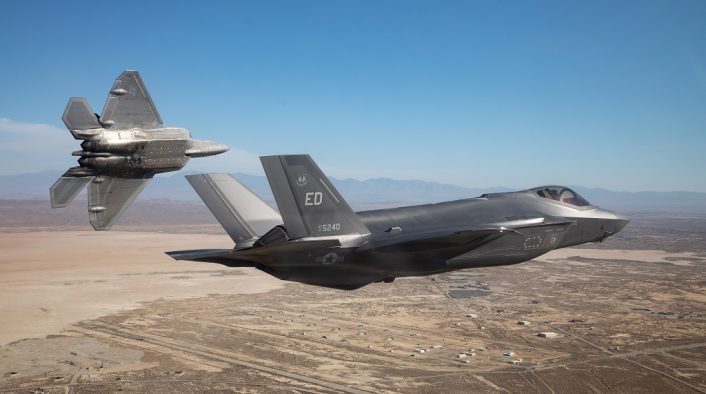
Recent incidents
As mentioned earlier, on July 18, 2025, a Delta Embraer E175, operated by SkyWest Airlines as flight DL3788 from Minneapolis to Minot, North Dakota, was forced to perform an “aggressive go-around” to avoid a U.S. Air Force B-52 Stratofortress operating in the vicinity of Minot. The incident occurred during the E175’s final approach to Minot International Airport, which shares airspace with Minot Air Force Base, home to the 5th Bomb Wing equipped with B-52 bombers.
The crew later explained to the passengers that the maneuver was necessary to avoid a B-52 that appeared on the approach path with no advance notice. The U.S. Air Force confirmed that the B-52 was performing a flyover at the North Dakota State Fairgrounds.
The service said in a statement that the flyover was planned in advance and approved by the Federal Aviation Administration, and the bomber was in contact will all air traffic control agencies. During the potential collision, the bomber was communicating with Minot International Airport’s tower, which however did not advise of the inbound commercial aircraft. Both the FAA and the Air Force are investigating the incident.
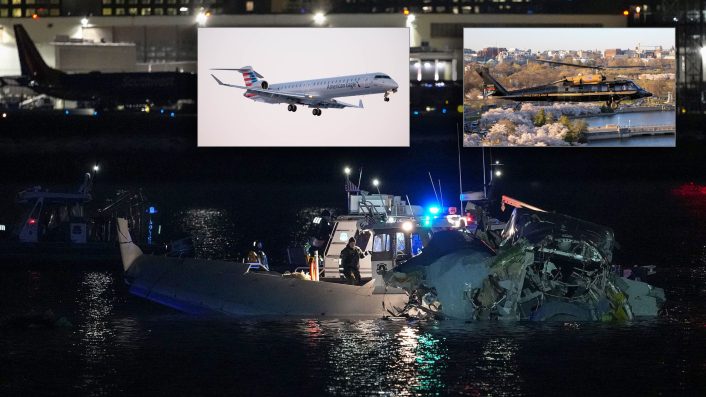
Another instance was the midair collision over the Potomac River, on Jan. 29, 2025, between a U.S. Army UH-60L Black Hawk and a PSA Airlines CRJ700 regional airliner, flying as Flight 5342. The accident resulted in the loss of all 67 individuals on board both aircraft, marking one of the deadliest aviation incidents in recent U.S. history.
The helicopter was conducting a VFR (visual flight rule) mission for the pilot’s annual standardization evaluation, utilizing NVGs (Night Vision Goggles). PSA Airlines Flight 5342, operating as a scheduled domestic passenger flight from Wichita Dwight D. Eisenhower National Airport (ICT) in Kansas to DCA, was on visual approach to runway 33.
The Black Hawk was traveling south along the Potomac River, and the CRJ700 was approaching from the south. The Black Hawk crew confirmed visual contact with the airliner and requested visual separation, with the controller later instructing the UH-60L to pass behind the CRJ700.
The collision, which was filmed from several different points of view, occurred at 8:47:59 PM, at an altitude of about 300 feet, as Flight 5342 was on final approach to runway 33. The collision left no survivors.

